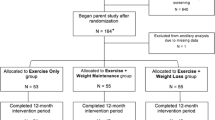Abstract
OBJECTIVE: To examine whether lipoprotein subfractions are associated with age-related changes in visceral obesity and maximal aerobic fitness in women athletes.
SUBJECTS AND MEASUREMENTS: Body composition was measured using dual energy X-ray absorptiometry (DEXA) and a single slice computed tomography (CT) scan of the abdomen of 39 women athletes (age: 18–69 y, body mass index (BMI): 19–24 kg/m2). Lipoprotein lipids were measured in plasma drawn after a 12 h fast using nuclear magnetic resonance (NMR) spectroscopy, which quantifies lipoprotein subfractions by the spectroscopic differences exhibited by lipoprotein particles of various sizes.
RESULTS: Total cholesterol (r=0.42; P<0.01) and low-density lipoprotein cholesterol (LDL-C) (r=0.32; P=0.05) correlated positively with age, even after adjustment for age-related decreases in maximal aerobic fitness (VO2 max) and increases in the intra-abdominal fat area. There were no relationships between any of the lipoprotein subfractions or sizes with age. Very-low-density lipoprotein (VLDL) size and VLDL2-TG correlated with total fat mass (r=0.40 and r=−0.43, respectively; P<0.05) and with intra-abdominal fat area (r=−0.47 and r=0.43, respectively; P<0.01), but not independently of total fat mass. Total cholesterol and LDL-C were negatively related to maximal aerobic fitness (VO2max) (r=−0.37 and r=−0.33, respectively; P<0.05), while low-density-lipoprotein (LDL) size was positively related to VO2max (r=0.35, P<0.05).
CONCLUSIONS: These results suggest that age-associated changes in lipoprotein concentrations are probably, in part, due to primary aging, rather than age-related changes in abdominal obesity and aerobic fitness.
This is a preview of subscription content, access via your institution
Access options
Subscribe to this journal
Receive 12 print issues and online access
$259.00 per year
only $21.58 per issue
Buy this article
- Purchase on Springer Link
- Instant access to full article PDF
Prices may be subject to local taxes which are calculated during checkout
Similar content being viewed by others
Author information
Authors and Affiliations
Rights and permissions
About this article
Cite this article
Nicklas, B., Ryan, A. & Katzel, L. Lipoprotein subfractions in women athletes: effects of age, visceral obesity and aerobic fitness. Int J Obes 23, 41–47 (1999). https://doi.org/10.1038/sj.ijo.0800755
Received:
Revised:
Accepted:
Published:
Issue Date:
DOI: https://doi.org/10.1038/sj.ijo.0800755
Keywords
This article is cited by
-
Body fat distribution and flow-mediated endothelium-dependent vasodilation in older men
International Journal of Obesity (2002)



